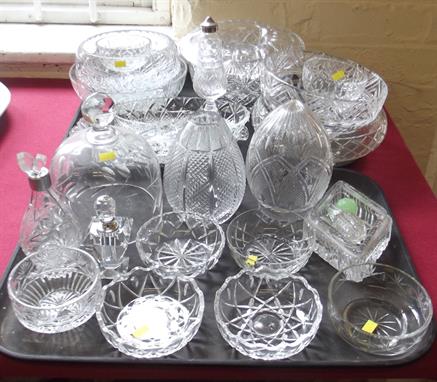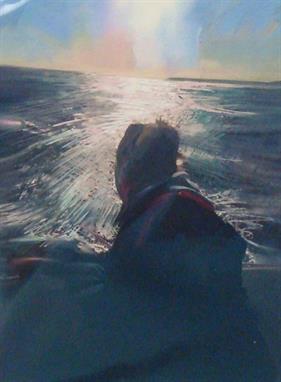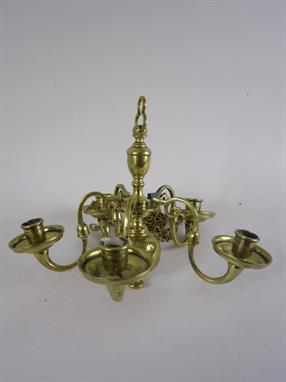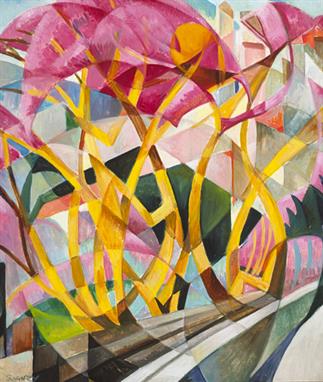We found 534338 price guide item(s) matching your search
There are 534338 lots that match your search criteria. Subscribe now to get instant access to the full price guide service.
Click here to subscribe- List
- Grid
-
534338 item(s)/page
Mid 20th century Chinese carved malachite figure of a woman with child 6", and five similar figures in different stones,Dark green is malachite - few minor losses and a repair, Dark blue is lapis lazuli - Numerous frits. Pink is rose quartz - frits. Opaque/orange is a form of agate - Repair to left arm and frits. Light blue are both composite - frits and chips.
Late 19th century Chinese semi formal robe of dark blue silk embroidered with flowers and butterfly in silk and knot stitch, contrasting cuffs with polychrome embroidery and brocaded border, lined with turquoise silk,Good condition Fabric strong colours unfaded , no damage to embroidery . The collar has come loose at the seam but fabric not damaged . Line of light discolouration edge of one sleeve internal panel
19th century Chinese wall hanging constructed out of a Qing dynasty Chi-fu dragon and phoenix robes, depicting five claw dragons amongst clouds and bats, the second robe for a female with five roundels of embroidery each with a phoenix amidst flowers and butterflies, blue silk lining, 101 x 208 cm,Fabric is strong, colours bright , no fading or damage to the embroidery seen . no stains , gilt thread in good condition. The top section has been turned over to make a sheath for a hanging pole this extends the length to 228 cm . There are two areas of fabric infill either side of the top section plain fabric with embossed stripes. The neck of the upper robe is filled with couched gilt thread fabric , either side of this on each edge there is a small quarter round of infill Lower half lined in light blue silk some areas discoloured, upper robe deep blue silk generally good.
Japanese Satsuma brooch depicting storks by a riverside, a cat`s eye chalcedony necklace and another of malacite beads,Brooch crazed. 4.7cm diameter. Malachite necklace - largest bead 1.1cm diameter. 40.5cm long. Small chips to some beads. Light wear and tear. Cat`s eye chalcedony - largest 1cm diameter. 41.5cm long. Mounts worn. Chips and scratches to stones.
Hornby Dublo 00 Gauge 2-Rail and 3-Rail Steam and Diesel Locomotives and track: repainted LMS grey Duchess of Atholl and renamed City of Lichfield with added smoke deflectors and 2-rail chassis, 3-Rail BR green D8000 with repainted light green roof, small quantity of boxed 3-rail track including Straights, Curves, Uncoupling Rail and Electric Points (2), in original boxes, P-G, boxes F (8)
A LATE VICTORIAN SILVER CLASSICAL DESIGN FIVE LIGHT CANDELABRUM, by MARTIN, HALL & CO., the solid silver top with acanthus leaf sconces between quatrefoil shaped nozzles and drip trays, raised on a fluted column, the square weighted base with rams head capped corners, swags and acanthus leaf border, 13 ½"" (34.2cm) high, Sheffield 1895, 55oz approx. gross
AN ELECTROPLATED ART DECO FOUR PIECE TEA SET, by FRANK COBB & CO, with angular scroll handles and raised on four stepped feet, teapot and hot water jug with black insulator handles, AN ENGINE TURNED OVAL TRAY, 16"" (40.5cm) diameter, A PIERCED SWING HANDLE CAKE BASKET AND A THREE LIGHT CANDELABRUM (7)
LATE VICTORIAN CAST AND PLATED TWIN LIGHT FIGURAL CANDELABRUM, modelled a s a nude male, kneeling on a naturalistic domed base, raised on three scroll feet, balancing a receiver on his head issuing two scrolling foliate arms and sconces, with central floral spray finial, 10 1/2"" (26.7cm) high EST 35-50
PU RU (1896 - 1963) MOUNTAIN LANDSCAPE China, undated. 81 x 25 cm. Ink and colours on paper. Hanging scroll, brocade mounting. Inscription: "The shadows of the poplars and willows caress the long bank, the spring waves reach the fishing boat. The sun will soon set, a light wind blows, carrying the fragrance of flowers from the opposite bank." Signed: Pu Ru. Oval seal before the inscription: Qing nanji. Seal after the inscription: Pu Ru Provenance: Collection of a Czechoslovak journalist. Obtained from master Liu Jintao in Beijing in the late 1950s. Reserve price: 220,000
William Percy French (1854-1920) ON THE ROCKS [ROCK OF CASHEL, COUNTY TIPPERARY] watercolour signed lower left; titled on reverse; with Oriel Gallery label on reverse 9.75 by 6.5in., 24.375 by 16.25cm. P Oriel Gallery, Dublin; Private collection;Whyte`s, 30 May 2011, lot 66A;Whence purchased by the present owner Nulty, Oliver, Lead Kindly Light, 35 Years of Percy French at the Oriel Gallery: A Millennium Retrospective, Oriel Gallery, Dublin, 2002, p.122 (illustrated)
Aloysius C. OKelly (1853-1936) UN VERRE DE VIN oil on canvas signed lower right 26 by 21.5in., 65 by 53.75cm. P Family of the artist An Exhibition of 17th - 20th Century Irish Paintings`, Gorry Gallery, Dublin, 19 May to 2 June 2010, catalogue no. 30 (illustrated p.28) O`Sullivan, Niamh, Aloysius O`Kelly: Art Nation, Empire, Dublin 2010, catalogue no. 81 O`Kelly executed a number of portraits of elderly men and women to exude character. These demonstrate his vigorous prowess as a portrait painter. What these portraits show is a progressively fluid and impressionistic treatment, as the handling becomes looser and livelier. The fisherman is dressed in his working clothes, smock and sabots. Pannier at his feet, he is smiling and at ease. Although verging on the monochromatic he seems to be full of the joys of life. Somewhat unusually or O`Kelly - who tends towards solemn when treating the fishermen and farmers, the labourers of the western seaboards of France and Ireland - this one has the air of a bon viveur. Sitting by the rustic table, bottle to hand, traces of Bonnat`s influence, specifically his rugged naturalism, can clearly be discerned. In the virtuosity of draughtsmanship, these portraits are a tribute to Gérôme while the loose yet controlled brushwork, broad values, and the use of dramatic light and shade are a testimony to Bonnat`s realist teaching. But, ultimately, O`Kelly`s portraits are his own. From the late 1870s through to his old age, he produced a range of rural portraits of considerable power. Although psychologically penetrative, in many respects these portraits are less about the individual than the human condition. We are grateful to the Gorry Gallery and Prof. Niamh O`Sullivan for their permission to reproduce this note.
Mary Swanzy HRHA (1882-1978) TREES oil on canvas signed lower left 21 by 18in., 52.5 by 45cm. P Family of the artist Although she studied art in Paris in 1905 and 1906 where she was amongst the first Irish artists to see the work of Pablo Picasso, Swanzy did not begin making and exhibiting Cubist inspired work until the 1920s and 1930s. She was one of Ireland`s most innovative exponents of this approach, using it in imaginative ways in a range of landscapes, figure studies and paintings of propellers. As she never dated her paintings, it is difficult to be precise about the chronology of the work, but she appears to have made and exhibited most of her Cubist inspired paintings after 1920. Having moved back to Dublin from Paris, Swanzy continued to travel widely visiting London, Italy, Czechoslovakia, Polynesia and the United States. She maintained contact with the French art world throughout the 1910s and 1920s, exhibiting at and becoming a committee member of the Salon des Independants, the largest show of modern art in Paris. Her work was shown at this venue alongside that of the Orphic cubists, Sonja and Robert Delaunay. Orphism, a hugely influential movement, was concerned with the impact of light and colour on the vision of the artist. The paintings of Robert Delaunay are preoccupied with aeronautical flight and altitude through which he could demonstrate how form is made of pure colour. The influence of these ideas is apparent in Trees. The bright colours and dynamic geometric patterning of the composition of Trees are also evocative of speed and movement. Swanzy was clearly aware of Italian Futurism and British Vorticism when she painted the work. Both movements stress the importance of dynamism in art and of representing technology. The railway track or roadway in the foreground of Trees suggests movement through the landscape resulting in a distortion of the forms. Swanzy`s father was a well-known ophthalmic surgeon and her fragmentation of the composition is equally reminiscent of ophthalmic lenses and optical devices.The giant pink trees with their swaying yellow barks are probably inspired by the exotic vegetation that Swanzy saw on her travels to Samoa and Hawaii in the 1920s. The tall towers in the distance (to the right) recur in several of her paintings, a memory of San Gimignano, the medieval city in Tuscany, near to Florence where the artist lived for a period before World War One. Swanzy draws on her vast experiences of travel and modern art in her work. The result is an inventive and unique engagement with Cubism and Futurism that was not always valued by her contemporaries in Dublin which she left in 1926 to settle with her sister in London. The originality of her work, however, ensured Swanzy`s rediscovery as one of Ireland`s most significant modernist painters at the end of her life in the 1960s and 1970s when she finally enjoyed critical and commercial success. Trees is an important example of her Cubist work.Dr. Róisín KennedyApril 2014
-
534338 item(s)/page

























































![William Percy French (1854-1920) ON THE ROCKS [ROCK OF CASHEL, COUNTY TIPPERARY] watercolour signed lower left; titled on re](http://lot-images.atgmedia.com/SR/10092/2903219/9-20145622211_468x382.jpg)


